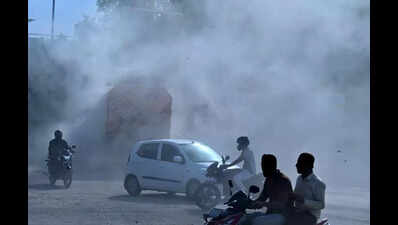Hyd gets heavy rain yet struggles to breathe easy | Hyderabad News

Hyderabad: Although the city received up to 120 mm of rainfall in May, the downpour did little to improve the increasingly polluted air quality in Hyderabad. A review of data from the Central Pollution Control Board (CPCB) over the last year reveals consistently high levels of pollutants across the city, including PM2.5, PM10, nitrogen dioxide (NO₂), carbon monoxide (CO) and ozone.According to CPCB analyses, air quality in areas such as Somajiguda, Kompally, the Old City and Gachibowli often falls into the ‘moderate to poor’ category, even during months typically associated with cleaner air.For example, PM10 levels in the Old City recently hovered around 150 µg/m³ — ten times the annual permissible limit of 15 µg/m³ — and even peaked above 200 in Nov last year. In July 2024, even amid peak monsoons, the reading remained high at 148.Concrete jungle, rising heatSimilarly, carbon monoxide levels remain consistently high throughout the year. At Somajiguda, the weekly average last week was an alarming 94 µg/m³, over 20 times higher than the permissible limit of 4 µg/m³. This figure was 56 µg/m³ in Feb and 63 µg/m³ in August 2024.Levels of NO₂ followed a similarly worrying trajectory, averaging around 32 µg/m³ in April and Nov, with a slight decrease to 29 µg/m³ in July — still nearly three times the safe threshold of 10 µg/m³.“Hyderabad’s landscape is dominated by concrete and asphalt, which absorb and radiate heat. This intensifies the urban heat island effect, raising local temperatures and reducing wind flow, both of which worsen air quality,” said Babu Rao, an environmental scientist. He added that: “When wind speeds drop and temperatures rise, pollution stagnates. The city ends up cooking its own emissions, especially in dense zones like Gachibowli and Somajiguda.“Bottlenecks drive emissionsTraffic emissions remain a major contributor to the crisis. Narsimha Reddy Donthi, an environmentalist who has conducted extensive research on urban pollutants over three decades, points to chronic congestion. “Hyderabad’s traffic rarely flows; it idles,” he said. “Every signal cycle, you see thousands of vehicles inching forward. Idling engines emit carbon monoxide and fine particulates that accumulate hour after hour.“He added that nearly 80% of the city’s NO₂ emissions come from diesel buses, three-wheelers and ageing petrol vehicles.“Ground-level ozone doesn’t come directly from tailpipes; it’s a product of chemical reactions. Sunlight and heat react with NO₂ emitted by vehicles and industries to create this invisible yet harmful gas. We need to address the source of these emissions,” he said.‘Need strict vehicle & fuel regulations’Experts are calling for a multifaceted response to Hyderabad’s deteriorating air quality. Rahul Goel, an air quality researcher from IIT Delhi, emphasised the importance of overhauling public transport, promoting non-motorised modes of transport such as cycling and walking, and enforcing stricter vehicle and fuel regulations. “There’s also a need for stricter monitoring of industrial waste and construction activity,” said Goel, adding: “Dust from construction sites is a major contributor to PM pollution. Simple measures, such as enclosing sites with curtains and sprinkling water, can significantly reduce airborne particles.”He stressed that policy alone isn’t enough without enforcement. “We may not be able to eliminate pollution, but we can contain it,” he added.
















